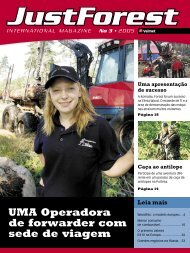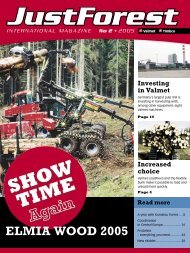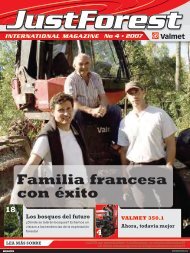English - Komatsu Forest
English - Komatsu Forest
English - Komatsu Forest
Create successful ePaper yourself
Turn your PDF publications into a flip-book with our unique Google optimized e-Paper software.
Optimized transport saves<br />
money and the environment<br />
A logistics management<br />
system for forest product<br />
transport developed<br />
in Sweden can save up to<br />
a fifth on transport costs.<br />
This saving is achieved<br />
by optimizing routes<br />
so that trucks make the<br />
shortest possible journey<br />
and with as little distance<br />
empty as possible.<br />
Transport costs the forest<br />
industry a great deal of<br />
money. In Sweden alone,<br />
each year transport costs the forest<br />
industry about SEK 4 billion<br />
(USD 625 million), representing<br />
some 25 percent of the industry’s<br />
total costs. The forest industry<br />
is also Sweden’s largest shipper,<br />
and of the 340,000 miles<br />
(550,000 km) of roads in Sweden,<br />
more than half, some 190,000<br />
miles (310,000 km), comprise<br />
forest roads. These forest roads<br />
are often in poor condition and<br />
during spring, when the ground<br />
thaws, restrictions can be placed<br />
on their use for transport. Consequently,<br />
it is important that forest<br />
companies know which roads<br />
can be used.<br />
A few years back, a national<br />
forest road database was established,<br />
containing all forest roads<br />
with information on everything<br />
from gross weights and accessibility<br />
to speed limits. Using the<br />
forest road database, the Swedish<br />
forestry research institute Skogforsk<br />
has developed a method to<br />
optimize forest transport routes<br />
that has proven to make forest<br />
transport up to 20 percent more<br />
efficient. What’s more, the environment<br />
is also saved through<br />
30 JUST FOREST NO 4 • 2007<br />
Bertil Liden, a logistics researcher<br />
at Skogforsk, explains that<br />
a logistics manager cannot possibly<br />
memorize all the necessary<br />
information. That’s why tools<br />
are needed.<br />
lower emissions.<br />
The tool is called RuttOpt and<br />
is an aid for planning the daily<br />
routes of a vehicle fleet, covering<br />
periods of up to seven days.<br />
Using the road database and<br />
advanced algorithms, it is possible<br />
to calculate the most efficient<br />
route for each vehicle.<br />
“Achieving this demands<br />
knowledge of sawmill timber<br />
needs, timber stocks, road conditions,<br />
and available vehicles. It’s<br />
impossible for a logistics manager<br />
to memorize all this information,”<br />
says Bertil Lidén, a logistics<br />
researcher at Skogforsk.<br />
IF THE PROGRAM is to help<br />
make the right decisions, the<br />
input data must be correct. For<br />
example, the reporting system<br />
used by forwarders must function<br />
properly. Optimization<br />
requires an accurate inventory<br />
of the volumes and assortments<br />
available at roadside landings.<br />
Other input data processed by the<br />
program includes sawmill needs<br />
Optimizing transport in various ways enables greater savings.<br />
Swedish Skogforsk has shown savings of up to 20 percent.<br />
broken down into daily quotas<br />
and every vehicle’s running costs<br />
per hour and mile. If the system<br />
is to function in an optimal man-<br />
Transport trucks<br />
run empty more<br />
often in the USA<br />
TRANSPORT HAS been receiving<br />
attention in the USA, too. Preliminary<br />
results of a study conducted<br />
by WSRI, the Wood Supply<br />
Research Institute, in the<br />
south of the USA shows that<br />
timber trucks average about 40<br />
miles (60 km) travel to a mill,<br />
and average 45 percent of daily<br />
miles loaded. Moreover, early<br />
results indicate timber trucks<br />
were only moving fully loaded<br />
25 percent of the time that the<br />
ner, the vehicles must cover large<br />
areas to create a greater number<br />
of alternatives that cut empty<br />
loads and increase efficiency. r<br />
engine was running. The survey<br />
data is being collected by equipping<br />
the trucks with GPS systems<br />
and scales with remote data<br />
recording, and data on machine<br />
movement is also being collected.<br />
Early study results show that<br />
transport planning can increase<br />
the proportion of fully loaded<br />
miles for better utilization of<br />
resources. Other WSRI studies<br />
address turnaround time at the<br />
mill. www.wsri.org. r






